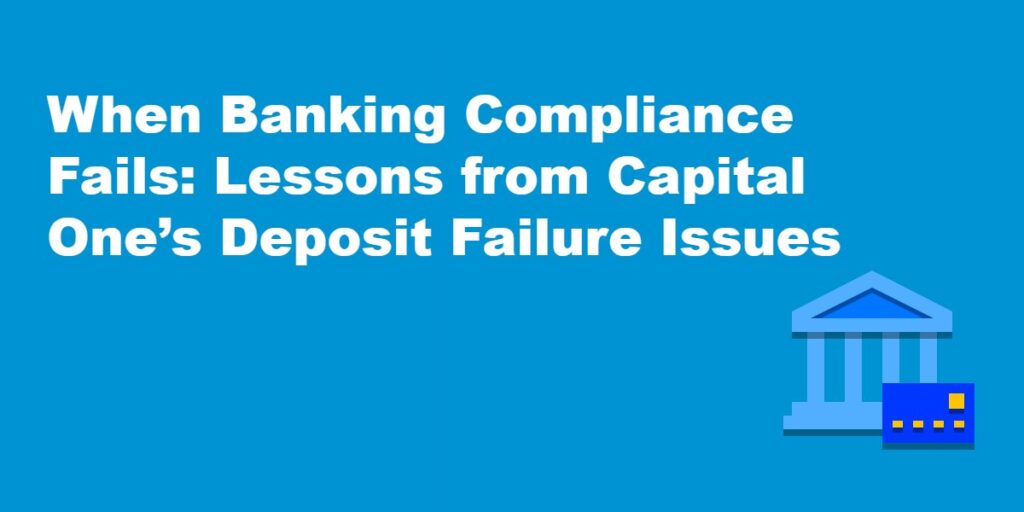Recent technical and deposit-related issues at Capital One have exposed vulnerabilities in its compliance and risk management frameworks. This has led to many negative outcomes, including widespread customer frustration, regulatory scrutiny, and reputational damage. Capital One is one of the largest banks in the United States. The bank has been recognized for its innovative credit card services and digital banking solutions.
Financial institutions can strengthen their compliance programs and build greater resilience in an increasingly complex regulatory environment by understanding what went wrong. In this blog, we aim to explore the latest developments surrounding Capital One’s recent service disruptions, the compliance obligations at stake, and the lessons these failures offer for the broader banking industry.
Capital One’s Deposit and Technical Issues: A Closer Look
February 2023 Outage
In February 2023, Capital One experienced a widespread outage that prevented customers from accessing their accounts online or through mobile apps for several hours. The issue was traced to a technical glitch in the bank’s cloud-based infrastructure, which disrupted transaction processing and account access. Customers were frustrated by delayed payments, missed deadlines, and a lack of timely communication from the bank.
This incident highlighted the risks of relying heavily on cloud technology without sufficient fail-safes. It also raised questions about Capital One’s internal controls and disaster recovery protocols. For a bank that prides itself on digital innovation, the outage was a stark reminder of the importance of operational resilience.
January 2025 Outage
A more severe disruption occurred in January 2025, when a multi-day outage prevented thousands of customers from accessing their accounts and delayed deposits and payments during a critical mid-month pay period. The root cause was a power failure at FIS Global, a third-party vendor responsible for Capital One’s payment processing and core banking services.
This outage highlights many common risks associated with over-reliance on third-party vendors and exposes gaps in Capital One’s contingency planning. Customers who were impacted faced significant financial hardships, with many unable to access their paychecks or make essential payments. The incident led to damaged customer trust and resulted in a class-action lawsuit.
Capital One’s Compliance Obligations: What’s at Stake?
As a federally regulated financial institution, Capital One must adhere to a range of compliance standards designed to protect consumers and maintain the integrity of the financial system. Key obligations include:
- Regulation E (Electronic Fund Transfer Act):
This regulation requires banks to investigate and resolve errors in electronic transactions promptly. Delays in resolving issues, such as those during the 2023 and 2025 outages, could violate Regulation E. - Truth in Savings Act:
Banks must provide clear and accurate information about deposit account terms, conditions, and fees. Customers must also be informed of any changes or disruptions that may impact their accounts. - Data Security Standards:
Capital One must comply with data privacy laws, such as GDPR, CCPA, and GLBA, which require banks to safeguard customer data and notify customers of breaches in a timely manner. - Third-Party Risk Management:
Regulators, such as the OCC, emphasize the importance of managing third-party risks. Banks must ensure vendors meet stringent operational and security standards.
What Went Wrong? Analyzing the Compliance Failures
The 2023 outage revealed several weaknesses:
- Inadequate Internal Controls: The technical glitch revealed a lack of robust testing and disaster recovery measures.
- Poor Communication: Customers criticized the bank for failing to provide timely updates, which added to their frustration.
- Over-Reliance on Cloud Infrastructure: While cloud technology offers scalability and efficiency, it also introduces risks that must be managed through redundancy and failover systems.
The 2025 incident highlighted additional vulnerabilities:
- Third-Party Dependency: The power failure at FIS Global showed the risks of relying on external vendors for critical services.
- Insufficient Contingency Planning: Capital One’s inability to quickly switch to backup systems or alternative vendors prolonged the disruption.
- Regulatory Non-Compliance: Delayed transaction resolutions and poor communication may have violated Regulation E and other consumer protection laws.
Both outages lay bare the importance of proactive compliance, robust risk management, and effective oversight of third parties.
The Role of Technology in Modern Compliance Challenges
Modern technology has undeniably improved banking transactions. When banking businesses are properly run, routine banking tasks are completed more efficiently, services are more personalized, and digital platforms are more intuitive. But these advancements come with complex compliance challenges that demand careful navigation.
Cloud computing offers clear advantages in scalability and cost savings, but as Capital One’s 2023 outage demonstrated, it requires rigorous oversight. Without proper testing, redundancy measures, and disaster recovery plans, the convenience of cloud technology can quickly turn into a liability.
Artificial intelligence presents similar contradictions. While AI streamlines operations from fraud detection to credit decisions, regulators are paying close attention to ensure these systems don’t inadvertently discriminate or make decisions that can’t be properly explained.
The cybersecurity landscape is growing increasingly threatening by the day. Regulations such as the NYDFS Cybersecurity Rules and GLBA establish clear requirements for protections, including data encryption and multi-factor authentication. For banks, the challenge is staying ahead of evolving threats while keeping pace with new regulations. Better solutions can be found in efforts to build compliance into technology from the ground up, rather than adding it as an afterthought.
Impact on Risk Management and Regulatory Adherence
Capital One’s recent struggles revealed critical weaknesses in its risk management approach. This came with serious repercussions. Regulators took notice when transaction errors and account access issues weren’t resolved promptly. Events like this run the risk of violating Regulation E and other consumer protections. Missteps like these often lead to increased scrutiny, potential fines, and mandatory corrective actions from agencies like the CFPB and OCC.
The damage extended beyond regulatory problems. Customers were furious and left negative reviews online and elsewhere. Financial impacts also followed, ranging from direct costs such as reimbursements and legal fees to intangible losses like customer attrition and damaged brand loyalty.
Erosion of Customer Trust
For banks, customer trust is everything. Capital One’s service disruptions in both 2023 and 2025 demonstrated how quickly trust can be eroded.
During the 2023 outage, customers became frustrated by the lack of clear communication, with many openly discussing the possibility of switching to competitors. The 2025 incident proved even more damaging. Delayed deposits and unsatisfactory customer service responses led to a class-action lawsuit.
These situations teach us fundamental truths about crisis management: transparency matters, accountability is non-negotiable, and resolution speed makes all the difference.
Lessons for the Banking Industry
Capital One’s recent struggles provide valuable insights for the entire banking industry. Here are five critical areas where financial institutions should focus:
- Build Stronger Compliance Foundations
Regular system audits, comprehensive testing, and ongoing staff training help catch issues early and maintain regulatory compliance. It’s not just about checking boxes—it’s about creating a culture where compliance is proactive, not reactive.
- Upgrade Risk Management Strategies
Service disruptions are inevitable, but their impact doesn’t have to be. Effective disaster recovery plans, backup systems, and contingency protocols for third-party services can significantly reduce downtime in the event of problems.
- Communicate with Customers—Early and Often
Banks require clear communication plans that utilize multiple channels, such as emails, text alerts, and social media updates, to keep customers informed in real-time. Transparency during crises preserves trust and mitigates the expense and severity of failure.
- Invest in Reliable Infrastructure
Cloud solutions and external vendors offer efficiency, but cannot be treated as set-and-forget protection against predictable failure. Financial institutions require robust backup systems and rigorous stress testing to ensure their technology can handle unexpected events with resilience.
- Vet Third Parties Thoroughly
Vendor relationships require active management. This involves conducting thorough due diligence before signing contracts, establishing clear performance standards in Service Level Agreements (SLAs), and regularly monitoring partners’ security practices and reliability.
The common thread? Prevention beats damage control every time. Banks that take these lessons to heart will be better positioned to avoid similar missteps and maintain customer confidence when challenges arise.
The Future of Compliance: Trends and Predictions
The compliance landscape is evolving rapidly, driven by technological advancements, regulatory changes, and shifting consumer expectations. One major trend is the growing emphasis on Environmental, Social, and Governance (ESG) compliance. Another key trend is the move toward real-time compliance monitoring, particularly in the case of anti-money laundering (AML) technology. Thanks to AI and machine learning, banks no longer have to scramble to address compliance issues after they arise. Issues and threats can be identified and addressed in real-time. For example, advanced transaction monitoring flags suspicious activity instantly. This makes it way easier to identify and address potential money laundering.
Regulators and stakeholders push banks to adopt sustainable practices, promote diversity, and ensure ethical governance. Take the EU’s Sustainable Finance Disclosure Regulation (SFDR), for instance. Laws like these require financial firms to disclose openly how they address ESG factors. Banks that meet these requirements ahead of schedule are able to build stronger trust with customers and investors.
Suppose banks plan to operate successfully in an increasingly globalized environment. In that case, they must navigate numerous international standards that must be met to achieve international compliance, such as the Basel III framework. I believe that compliance will increasingly focus on protecting consumers. Regulators are demanding greater transparency, fairness, and ease of access. Banks that adapt quickly and build flexible compliance frameworks will, ultimately, lead the pack.
Conclusion
Capital One’s recent deposit and technical troubles serve as a stark reminder: compliance and risk management can’t be an afterthought. Other financial institutions should take note—fixing vulnerabilities, tightening regulatory practices, and winning back customer confidence must be top priorities.
In today’s fast-moving, interconnected financial world, banks can’t afford to be reactive. The key to long-term success in this space lies in proactive risk management, robust infrastructure, and transparent communication with customers. Those who invest wisely now will be the ones setting the standard tomorrow.


